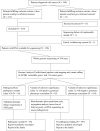Nationwide germline whole genome sequencing of 198 consecutive pediatric cancer patients reveals a high incidence of cancer prone syndromes
- PMID: 33332384
- PMCID: PMC7787686
- DOI: 10.1371/journal.pgen.1009231
Nationwide germline whole genome sequencing of 198 consecutive pediatric cancer patients reveals a high incidence of cancer prone syndromes
Abstract
Purpose: Historically, cancer predisposition syndromes (CPSs) were rarely established for children with cancer. This nationwide, population-based study investigated how frequently children with cancer had or were likely to have a CPS.
Methods: Children (0-17 years) in Denmark with newly diagnosed cancer were invited to participate in whole-genome sequencing of germline DNA. Suspicion of CPS was assessed according to Jongmans'/McGill Interactive Pediatric OncoGenetic Guidelines (MIPOGG) criteria and familial cancer diagnoses were verified using population-based registries.
Results: 198 of 235 (84.3%) eligible patients participated, of whom 94/198 (47.5%) carried pathogenic variants (PVs) in a CPS gene or had clinical features indicating CPS. Twenty-nine of 198 (14.6%) patients harbored a CPS, of whom 21/198 (10.6%) harbored a childhood-onset and 9/198 (4.5%) an adult-onset CPS. In addition, 23/198 (11.6%) patients carried a PV associated with biallelic CPS. Seven of the 54 (12.9%) patients carried two or more variants in different CPS genes. Seventy of 198 (35.4%) patients fulfilled the Jongmans' and/or MIPOGG criteria indicating an underlying CPS, including two of the 9 (22.2%) patients with an adult-onset CPS versus 18 of the 21 (85.7%) patients with a childhood-onset CPS (p = 0.0022), eight of the additional 23 (34.8%) patients with a heterozygous PV associated with biallelic CPS, and 42 patients without PVs. Children with a central nervous system (CNS) tumor had family members with CNS tumors more frequently than patients with other cancers (11/44, p = 0.04), but 42 of 44 (95.5%) cases did not have a PV in a CPS gene.
Conclusion: These results demonstrate the value of systematically screening pediatric cancer patients for CPSs and indicate that a higher proportion of childhood cancers may be linked to predisposing germline variants than previously supposed.
Conflict of interest statement
The authors have declared that no competing interests exist.
Figures


References
-
- Kirkeleit J, Riise T, Bjørge T, Christiani DC, Bråtveit M, Baccarelli A, et al. Maternal exposure to gasoline and exhaust increases the risk of childhood leukaemia in offspring–a prospective study in the Norwegian Mother and Child Cohort Study. Br J Cancer. 2018;119:1028–1035. 10.1038/s41416-018-0295-3 - DOI - PMC - PubMed
-
- Waszak SM, Northcott PA, Buchhalter I, Robinson GW, Sutter C, Groebner S, et al. Spectrum and prevalence of genetic predisposition in medulloblastoma: a retrospective genetic study and prospective validation in a clinical trial cohort. 2019;19:785–798. 10.1016/S1470-2045(18)30242-0 - DOI - PMC - PubMed
Publication types
MeSH terms
LinkOut - more resources
Full Text Sources
Other Literature Sources
Medical
Research Materials

